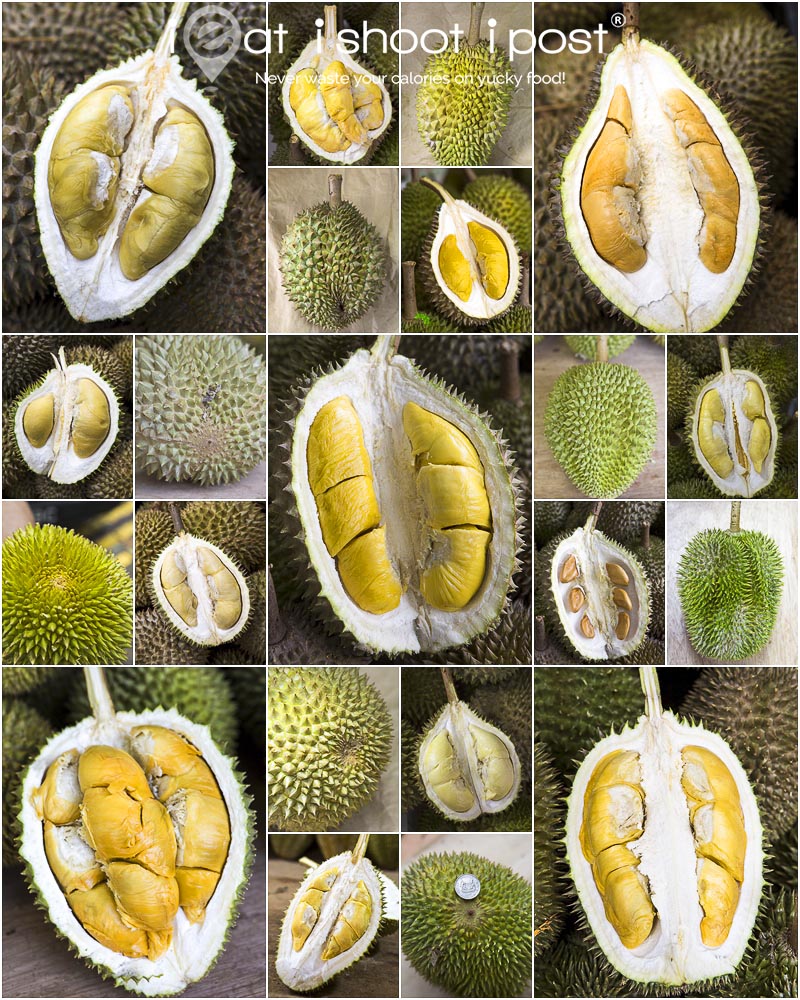
he durian scene has changed markedly from when I was a kid. Durians used to be just durians. We never used to have special names attached to them. Then around the late 2000’s, the D24 appeared on the scene which heralded the age of the durian cultivars. The D24 Sultan dominated the scene for a few years before it’s throne was usurped by the Musang King! As known as Mao Shan Wang or Raja Kunyit currently still reigns supreme!
I started writing about the different cultivars in 2012 when the trend was just heating up. Now, most durian lovers should be familiar names like Ang Hei, Tek Kah, D13 etc. In this post, I have consolidated the durian identification guide and tasting notes of 29 varieties, which I have gathered over the years for your easy reference! And I have listed some places to buy them at the end of the post.
Knowledge is your best safeguard against getting scammed!
1. D197 Mao Shang Wang
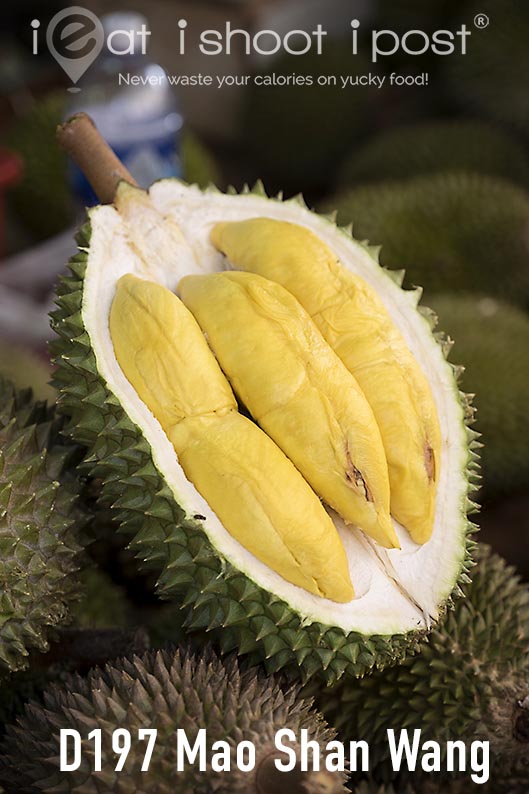
I start with Mao Shan Wang (Musang King, Raja kunyit) because it is still the most sought after durian by the masses and easily the most expensive. If you are a Mao Shan Wang newbie, it pays to know a little bit about this particular cultivar so that you get what you pay for.
Origins of the Musang King
The Musang King originated from a very old tree in Gua Musang, Kelantan. But it wasn’t till the 80’s that a man named Tan Lai Fook (Fook Gor Farm) stumbled upon the tree in Gua Musang. He and brought a branch back to Raub and started cultivating it. Today, Mao Shan Wang from Raub and neighbouring Bentong in Pahang are still regarded as the best in Malaysia. (You can buy durians direct from Fook Gor farm in Singapore at 99 Old Trees)
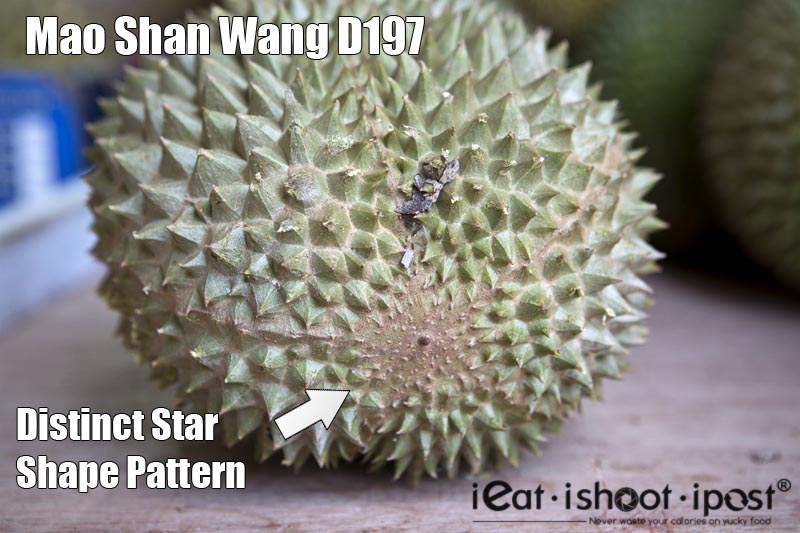
Mao Shan Wang Durian are usually oval to ellipsoid shaped, light green in colour (sometimes ash brown) and have thick and short, spines which resemble the pyramids of Giza.
The Tell Tale Sign of a Mao Shan Wang
The tell tale sign is the star shaped pattern at the bottom of the Durian (assuming the stalk is the top). This is an area of brownish discoloration which looks like a starfish hanging onto the Durian for dear life. At the other end of the fruit, look for spikeless ring at the base of the stalk.

The flesh of the Mao Shan Wang is a very characteristic deep buttery, flurorescent yellow colour. It should have a very rich, sweet and sometimes bitter flavour. The flesh should be dry, creamy and you should be able to easily lift it off the seed, which is often shrunken especially if it is from an old tree.
When and how to get a good Mao Shan Wang
Do take note that the Johor durian season peaks around June-July with a smaller season in December. The Pahang season peaks in Aug-Sep with a small season in January.
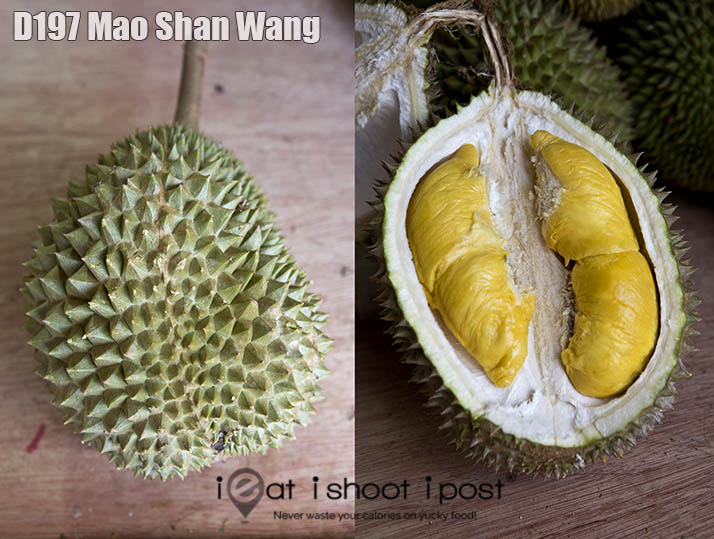
Now, just because you paid $22/kg for a Mao Shan Wang, it doesn’t necessarily mean it is the best. In fact, the best Mao Shan Wang you are going to ever eat would probably cost less because you would have eaten it at the peak of the season when the prices drop due to the large number of fruits falling off the trees!
The quality of Mao Shan Wang depends on many factors. Like which plantations it comes from and depends on the weather during the pre-season. Our Mao Shan Wang generally come from two places, Johor and Pahang. The ones coming from the Raub and Bentong region in Pahang are considered the best. Because these plantations are further away, they usually only arrive in Singapore after 8pm. The Johor durians usually arrive earlier in the afternoon.
That previous statement is true in general, but you do still get very good durians coming from Johor. There are some plantations in Johor with old trees producing good fruits. Another thing to bear in mind is that even fruits from the same tree might be of different quality. These fruits undergo a selection process, first at the farm or wholesale centre and then at the durian stall.
The bottomline is this, and this is the best advise I can give you. If you want good durians, make sure you find a durian seller you can trust. Build a good relationship with him so he can choose the good durians for you!
Black Gold – Cream of the Mao Shan Wang
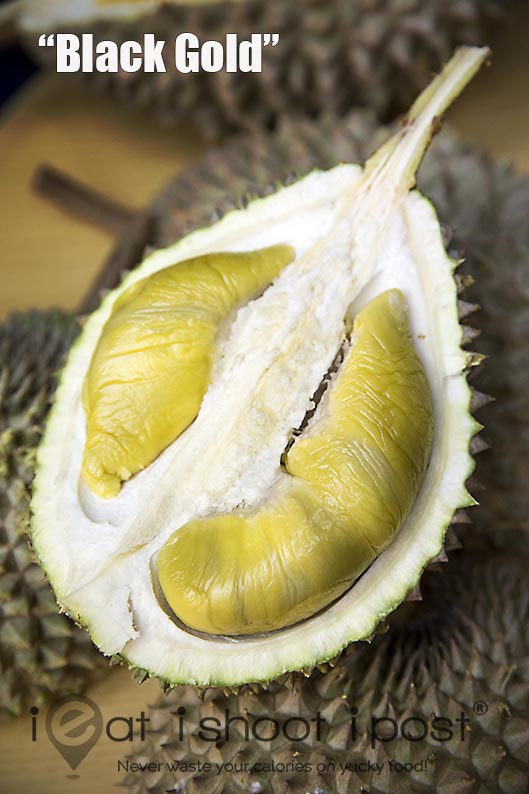
More recently, durians sellers have started to differentiate between the different grades of Mao Shan Wang. As result, you might have come across names like “King of Kings” or “Black Gold”. These are simply the cream of the Mao Shan Wang crop that usually come from old trees. These labels are subjective and is determined by the durian seller who would sort out the fruits when the lorry arrives. The smaller and odd shaped ones might be sold for $12-$15/kg. The average MSW will go for $18-$20/kg and the best ones will be labelled “Black Gold” and sold at $23/kg.
If you are sold a top grade, “Black Gold” durian, you should expect to see the dark greyish green seams. These are a sign of a mature durian tree capable of producing deep, bitter, complex flavours with a musky, seductive (repugnant to some) aroma.
D197 Mini Mao Shan Wang

Most of the Mao Shan Wang that you see are good sized fruits which have been pre-selected. Ever wonder what happens to the smaller, odd shaped fruits. Well, some dealers actually specially bring in these small, less than 1 kg Mao Shan Wang. That’s because there are some Mao Shan Wang devotees who would do a Mao Shan Wang degustation and taste fruits from different trees and plantations! That way you get to appreciate a wider variation of flavours! Mini MSW are usually cheaper as the flesh to husk ratio is smaller than a large fruit.
2. D198 Golden Phoenix

If the Mao Shan Wang is the current King of Durians then many say that the Golden Phoenix (金凤) is the Queen. This small to medium sized durian is named after the couple who first registered it. The man was Jing (金 – Golden) and the lady was named Fong (凤 – Phoenix), hence the durian is Jin Fong 金凤! The fruit is registered in 2013 and owned by Tan Sue Seng from Batu Pahat and is mostly grown in Johor.
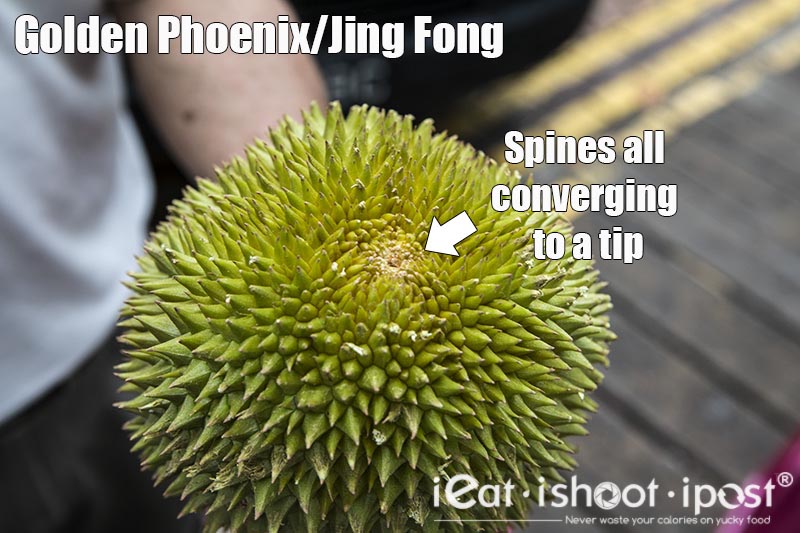
Although it is a small durian, the flesh to husk ratio of the Golden Phoenix is very good because of its thin husk and small seeds! The fruit is often roundish and oval in shape. The spines are small and spindly and they converge and get squashed up culminating in a distinctive tip at the base of the fruit. The colour can vary from light green to greyish brown if they are grown on the top of the mountain.
The flesh is a pale yellow colour and is dry but not overly pastey and it has a floral aroma. This durian is not as pungent and not overly sweet and is a good durian for beginners to start with.
3. D175 Ang Hei
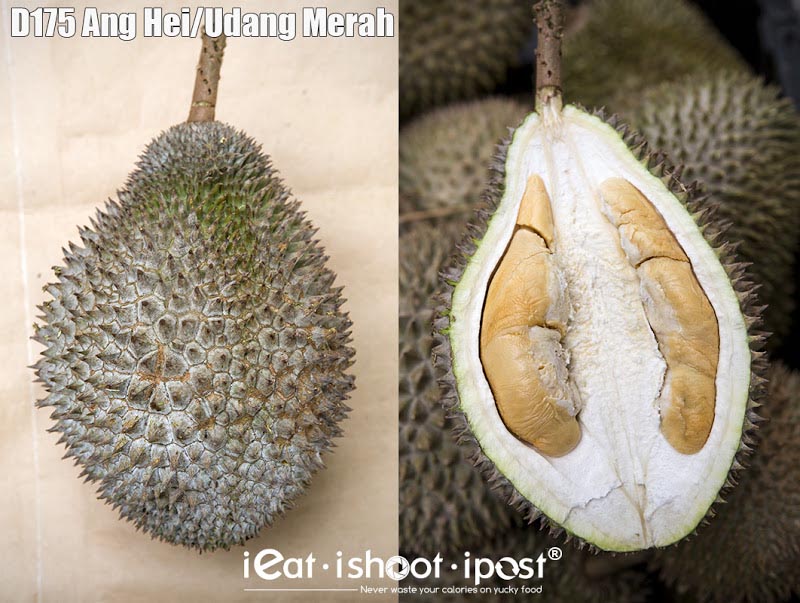
The Ang Hei is a much coveted fruit especially in Penang where it is said that it is even more popular than the Mao Shan Wang. It is not surprising since the fruit originated from there. I have yet to eat a Ang Hei from Penang since the journey is too long for the lorries to transport them to Singapore. Most of the Ang Hei here comes from Johor. I am told by the Durian experts that the Johor Ang Hei is no where near what they are like in Penang. But I have tasted some really good ones from Johor so I can only imagine how much better they can be in Penang!
The D175 is a fairly large fruit which can weigh between 1.5kg to 3kg. It is usually ellipsoid, elongated in shape, like an American footbal. The thorns are concave and spiny. The exterior is typically brownish green in colour which looks like its been covered with ash. The shell of the Ang Hei is rather thick, so you don’t tend to get as much flesh per kg of fruit. The flesh itself is a pastel orangey colour, dry, sweet and creamy with a very distinct flavour. If you are lucky you might chance upon one with dark greyish seams which are wonderfully bittersweet!
4. D24 Sultan
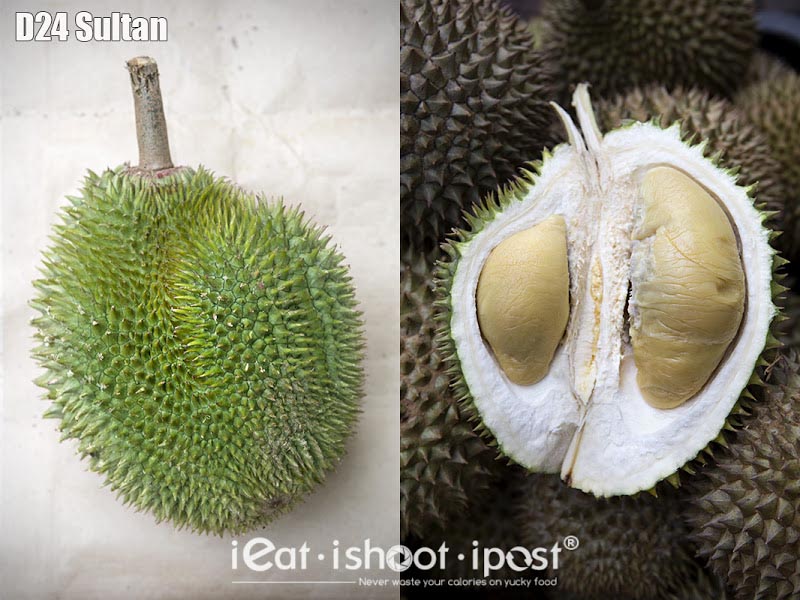
The D24 Sultan used to be the most popular cultivar before it was dethroned by the Musang King. But don’t discount it as it is still a very good durian with thick and creamy flesh and pungent flavour.
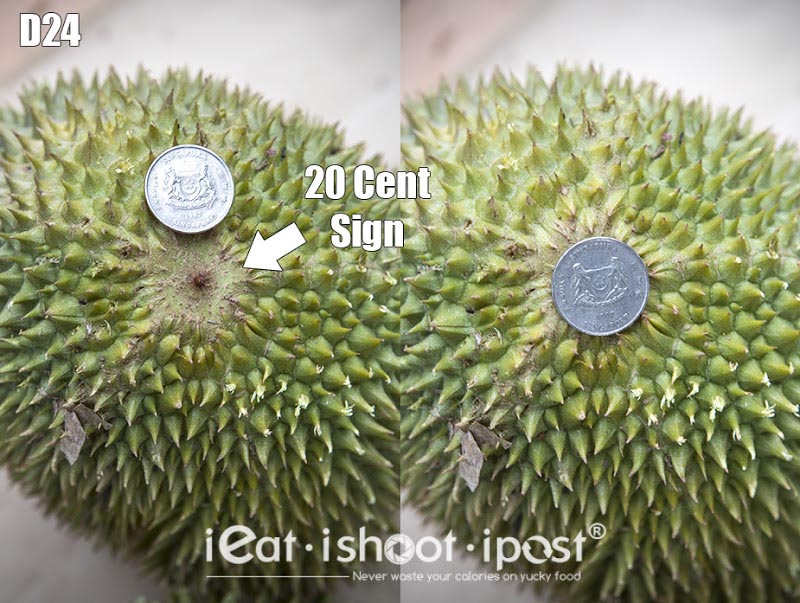
The D24 is typically a small to medium sized fruit usually between 1 to 2 kg with a thick light green husk and spines which are hooked only at the at the tips. One of the tell tale signs of a D24 is the “20 cent” sign which is an area at the base of the Durian that is devoid of spines around the size of a 20 cent coin.
The flesh is generous, thick and yellow, very smooth and creamy with a bit of fibre that develops more flavour as you chew. Each seed may be so well endowed that you probably would get satisfied only with a few seeds. It has a higher fat content compared to other durians which explains its rich luxrious mouthfeel!
The name “Sultan” was coined by Combat durian many years ago!
5. D200 Black Thorn
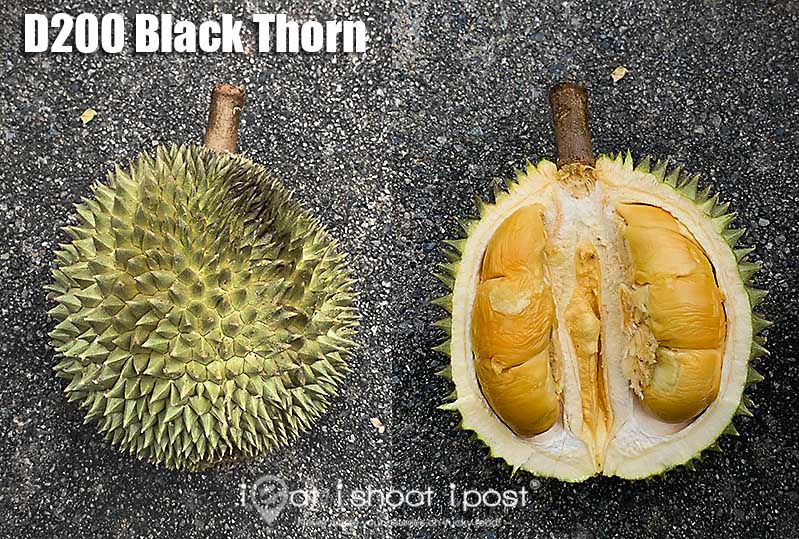
Lately, there has been one durian which has been able to outprice the Mao Shan Wang and that is the Black Thorn. This durian originated on the mainland side of Penang state and won first prize in the Penang State Durian competition in 2011 and 2012. It was only officially registered as D200 in 2013. They are only starting to grow this cultivar so it might be a few years before we get to see more of it during the season.
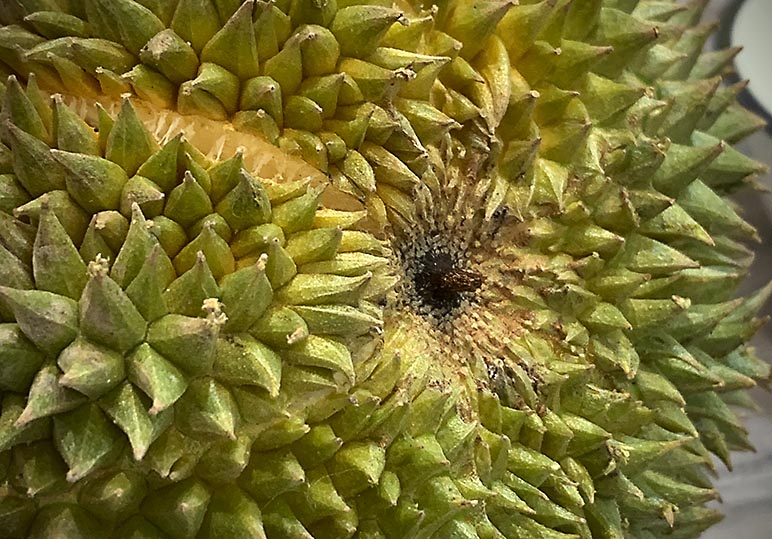
The fruit is roundish in shape and has a short stem. It got its name from the dried up stamen at the bottom of the fruit which is usually about 1.5cm long and protected by a dent at the base of the fruit. The flesh is a characteristic deep orangey golden hue which commands attention. Like the Green Bamboo, the fruit is also characterised by a hollow core.
So far the Black Thorns that I have tried have been quite dissapointing and it really isn’t worth its $30/kg price tag. But I expect that over the years, the quality will improve as the trees in Johor mature.
6. D168/D101 Johor Mas
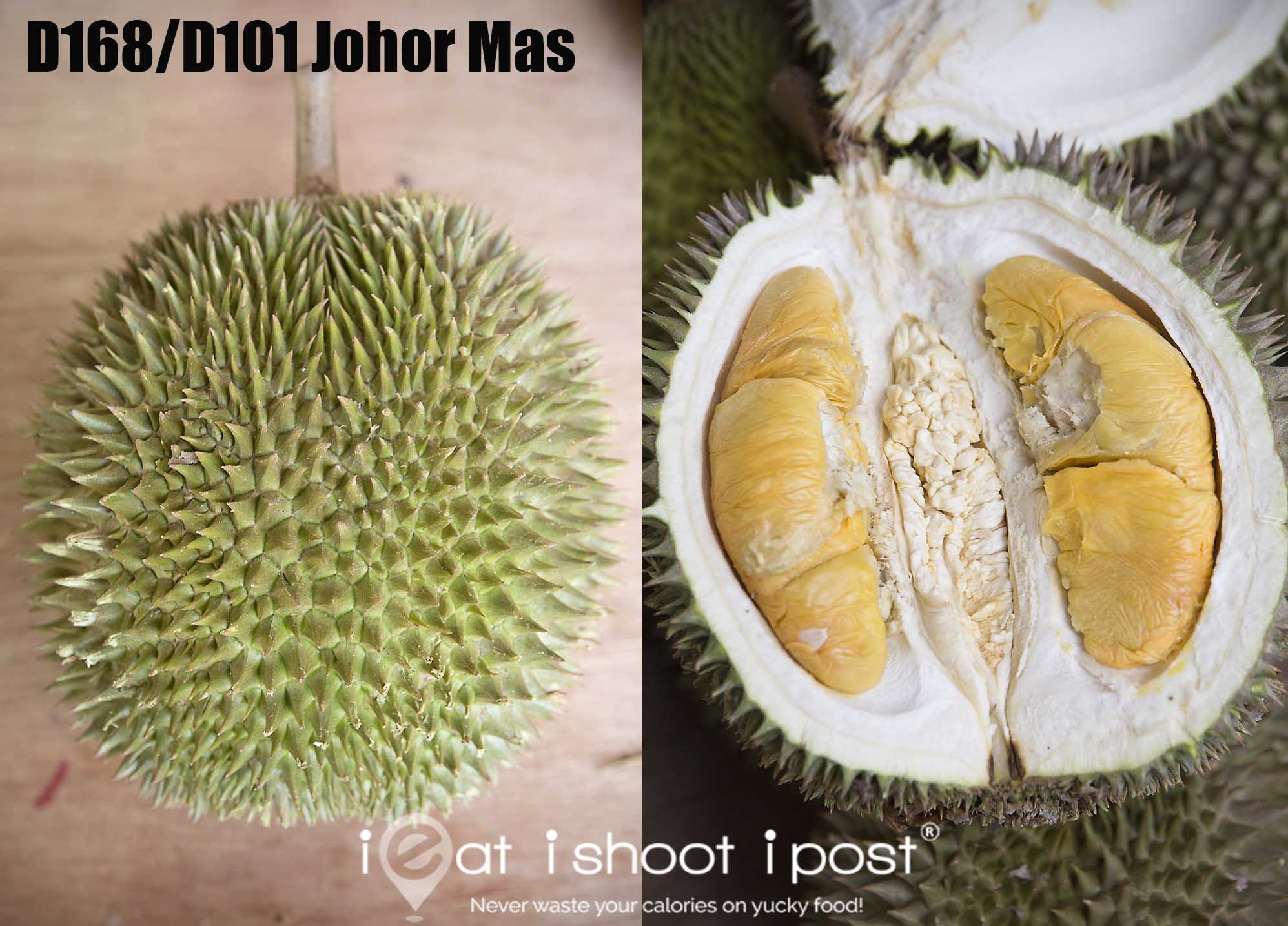
The D101 originated from Muar, Johor and was originally registered as D168 in 1989 to Mr Haji Hasmah. Somewhere along the way, the name changed to D101. How it happened is anyone’s guess.
It is a large, roundish shaped fruit with numerous spines which are long and spindly. The flesh is a very pleasing orangey gold color and it is thick, soft, sweet and creamy but can turn watery quickly. The orangey colour of the flesh is resembles the Ang Hei (D175) and as a result, it is sometimes known as the the Johor Ang Hei. As with all cultivars, if you manage to find one from an old tree, the flavour can be quite bittersweet and exceptional!
7. D13
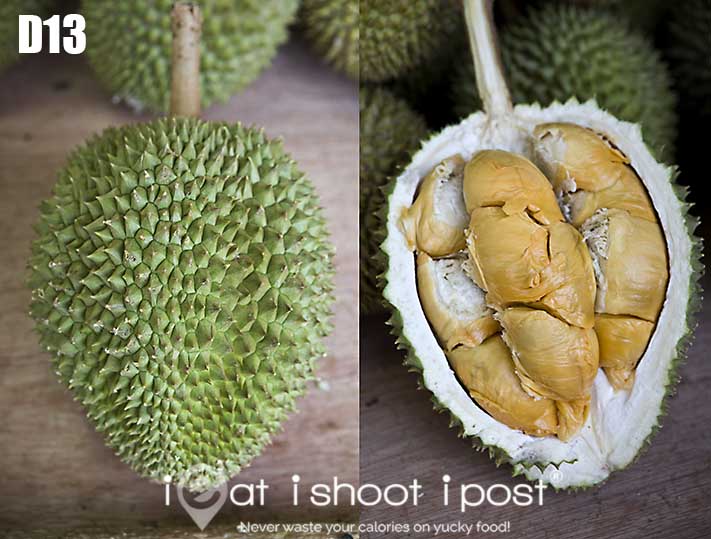
Another cultivar that has a similar deep orangey coloured flesh is the D13. It is around the same price as that of the D101 but it has a thicker and heavier husk, so you will end up paying a bit more for a fruit of the same size as the D101. The shape of the D13 is typically sharp and pointed at the bottom end as opposed the the more rounded rectangular shape of the D101 and the thorns are thicker.
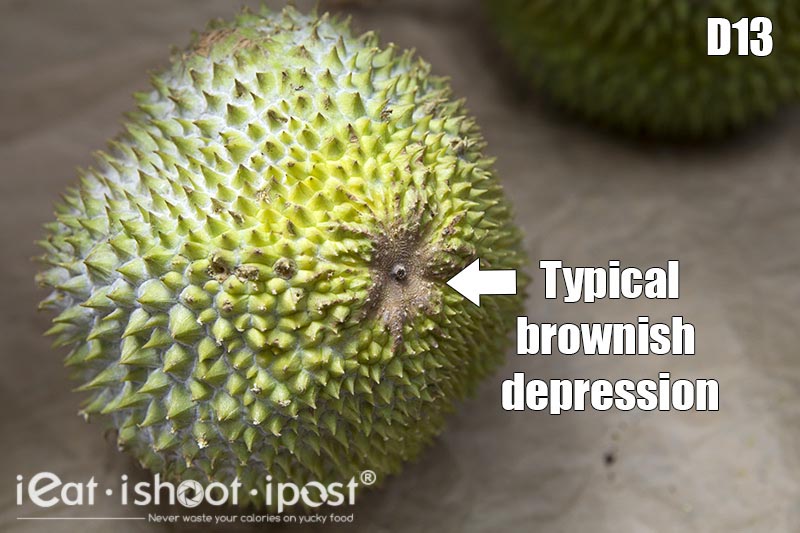
The flavours can range from one dimensional sweetness to a more complex bitter-sweetness. The flesh is a very impressive deep orangey red hue with areas of grey denoting its bitterness. The flesh is slightly fibrous so you can really chew on it. It is an easy durian to eat as it is not pastey and very light on the palate. The quality of the D13 is a very consistent and most fruits are good when they are opened so there is little wastage.
8. D160 Green Bamboo/Tek Kah
The Green Bamboo, is a cult favourite amongst some durian afficianados. The fruit is usually quite large, oval or ellipsoid in shape and easily recognized its characteristic hollow core which makes it quite a difficult durian to open!
The flesh is pale greyish yellow, smooth and it has a characteristic pungent, almost mineral like aroma which its devotees can’t get enough of. The flesh is smooth and creamy with bitter notes.
9. XO
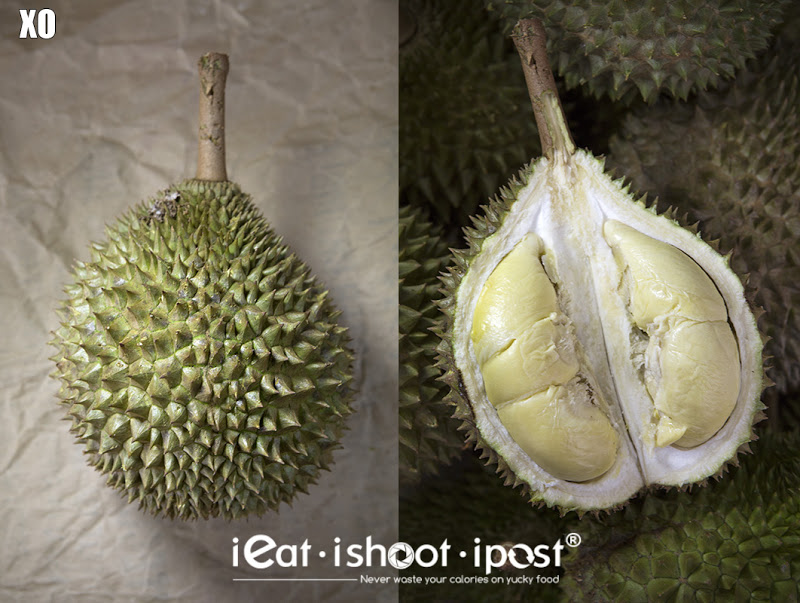
One of my favourite durians is the XO. When fresh, the flesh of the XO is dry to touch, but very soft. The membrane breaks when you bite into it and like an egg yolk, the runny contents oozes into your mouth, filling it with a complex bitter-sweetness with a touch of brandy which I really enjoy.
The fruit is usually small to medium sized and can range from round to pear shaped with thorns with have a dark green base which end in brownish tips.
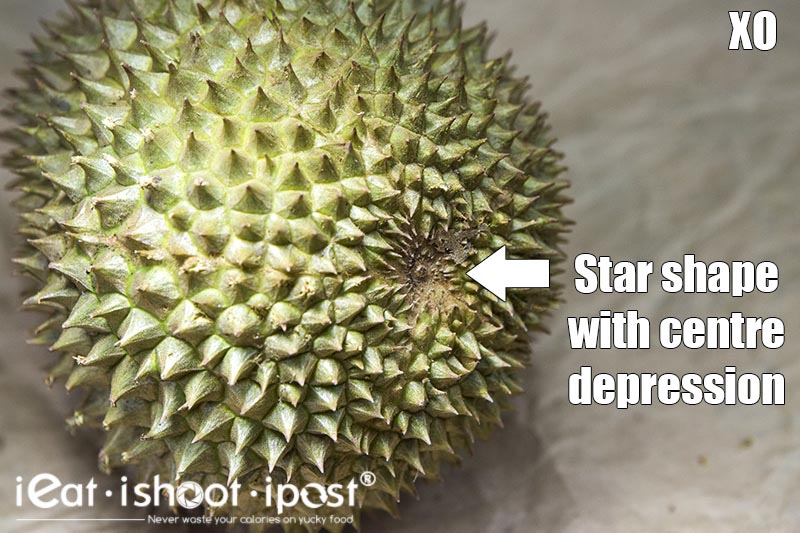
The XO also has a star shaped pattern at the bottom but unlike the Mao Shan Wang, the centre of the star is depressed. (It’s an innie, not an outie!) The brownish colour eminates from the centre of the star and follows the seams of the durian all the way to the stem.
10. Tai Yuan/Black Pearl
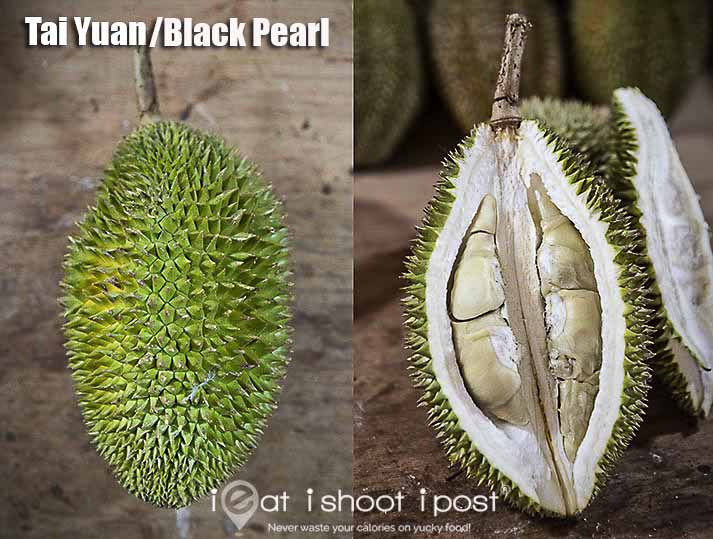
The Black Pearl should appeal to all the Captain Jack Sparrow wannabes out there! This is another one of those cult durians which some connoisseurs specially go for.
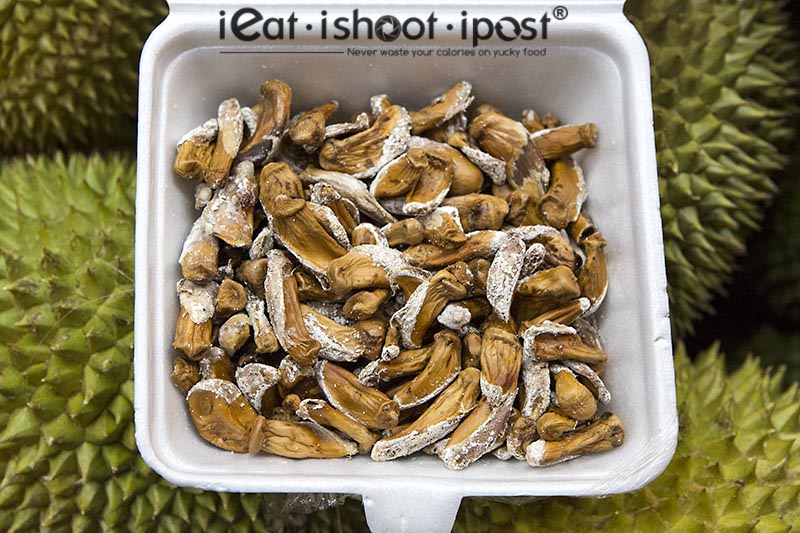
The fruit is typically elongated and shaped like an American football and it typically has a pointed tip at the base of the durian. The thorns are small and sharp and the husk is green in colour. The most tell tale sign is the shape of the seeds which are mostly shrunken and dark in colour which resemble little black pearls, hence the name. The greyish flesh is fibre free and very smooth and slighty tacky. Its bittersweet taste and unique fragrance is what lovers of this particular durian really go for!
11. D163 Hor Lor
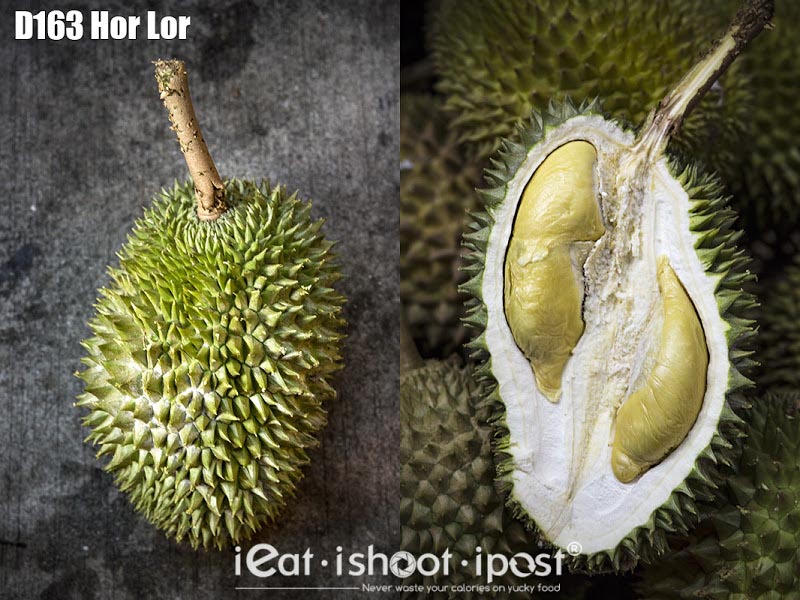
The D163 Hor Lor is so named because of its cylindrical, oval shape with a slight depression in the middle making it look like a bottle gourd. It has won awards in the 1987, 1988 Penang Durian competition. The flesh is dry, sticky and sweet bitter to taste. Good for those who enjoy the thick, pastey type of flesh that coats the palate and the throat.
12. D1 Gang Hai
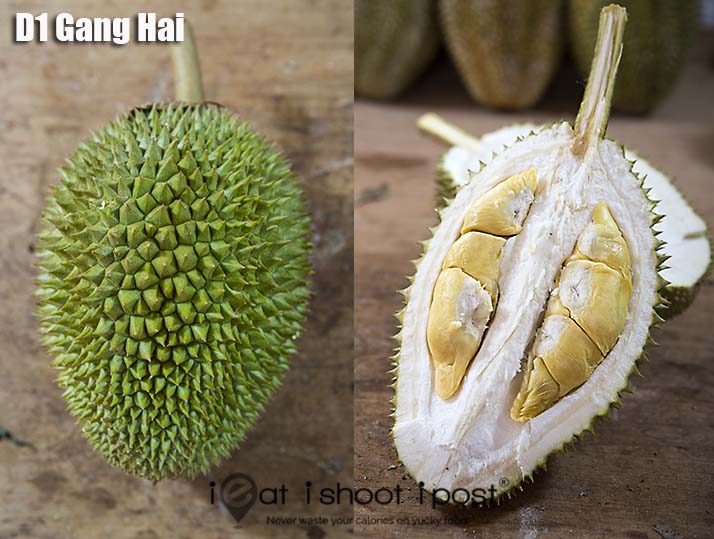
Gang Hai 江海 was a famous Segamat Durian in the past before the branded durians like D24, XO and Mao Shan Wang became popular. They have a short season and are only available during June – July. They are often the durian that heralds the start of the durian season. Unlike the other branded durians, these have not been grafted. There are only four plantations left in Segamat which are still producing these durians, so they are quite rare.
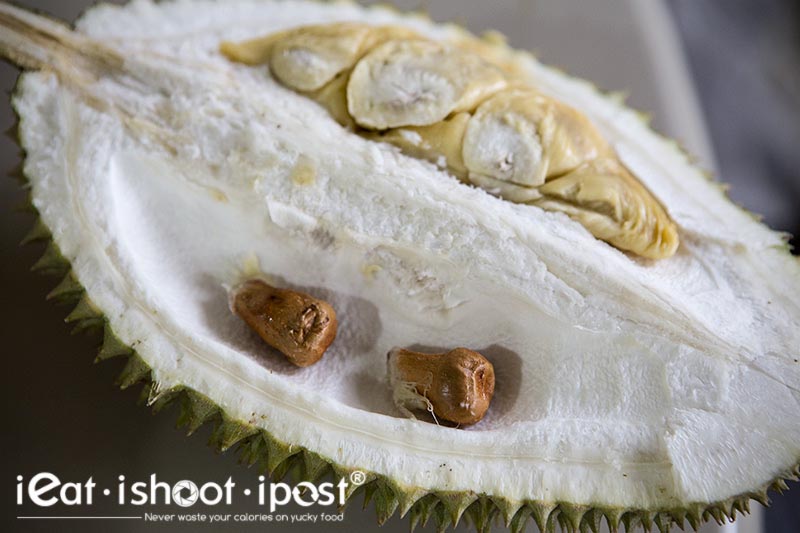
Durain devotees who go for Gang Hai don’t actually go for thick flesh, creamy and sweet durians. The flesh of the Gang Hai is more dry and pastey and it is fibrous so you have to chew it a bit. The pleasure of eating Gang Hai is derived from chewing the fibres and enjoying the slow release of the flavours. The flesh also tends to coat the mouth because of its stickiness, which is something the connoisseur goes for.
The seeds of the Gang Hai are always shrunken and characteristically bell shaped. So you do get a good amount of flesh, although overall, the flesh to husk ratio is rather small. They are also known as “Pop Corn” Durians because they are dry and relatively small sized. So you can pop them into your mouth like Pop Corn and your fingers will remain clean.
Gang Hai are available from Ah Kok durians.
13. D17/S17 – “Coffee” Durian
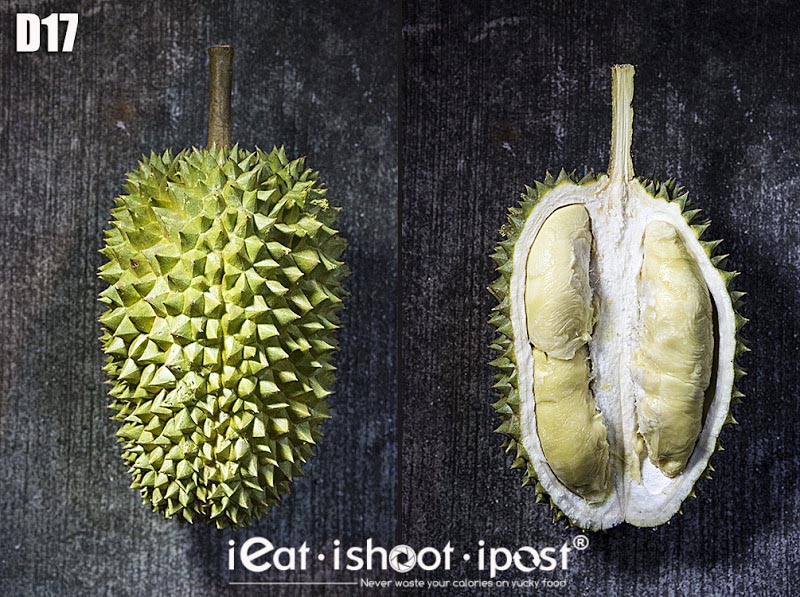
D17 has large thorns and its elongated shape makes it look quite similar to the Green Bamboo (Tek Kah). However, unlike the Green Bamboo, it does not have the “longgang” at the core of the fruit.
The flesh is dull yellow and it also ripens quickly so the fruit is often quite wet by the time it gets to Singapore. This is the reason why they are not cultivated widely as not many durian sellers want to sell a durian that cannot be kept overnight. In Penang, it has quite a cult following as they go for its unique bitterness which is liken to that of coffee thus giving it its popular nickname, “Coffee Durian”. When the flesh is dry, it lacks that unique bitterness. So if you manage to get a dry one, you might want to wait for it to ripen a little more before you eat it to get your coffee kick!
Of late, some durian sellers have changed the D to an S can have been marketing it as the S17. I think the S is supposed to give you the impression that it is supposed to be “Super”!
14. D162 Tawa
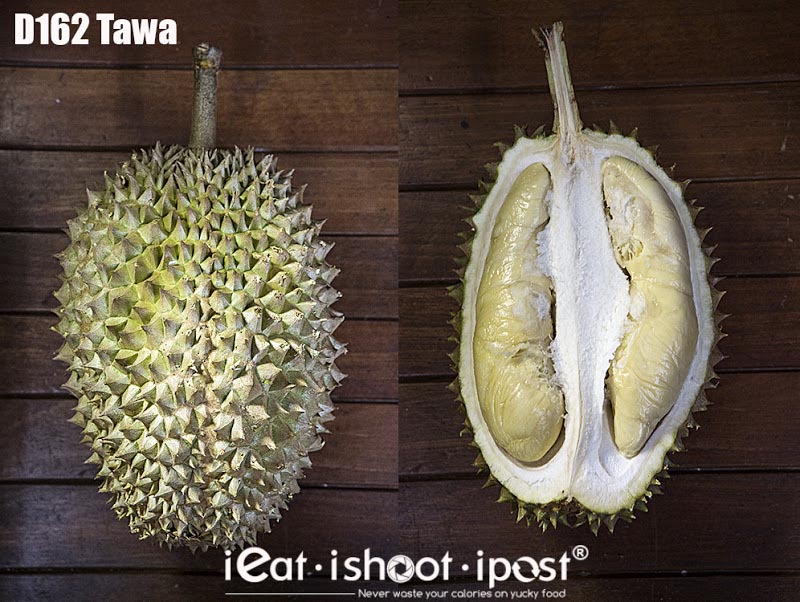
The Tawa comes from Tangkak and was originally registered as D162 in Selangor. But I am told that it is called Tawa because it originally came from the region of Tawau in Sabah.
The Tawa is a oblong shaped durian with flesh that is pale yellow, less creamy and more watery and very pungent. Quite similar in flavour to the XO.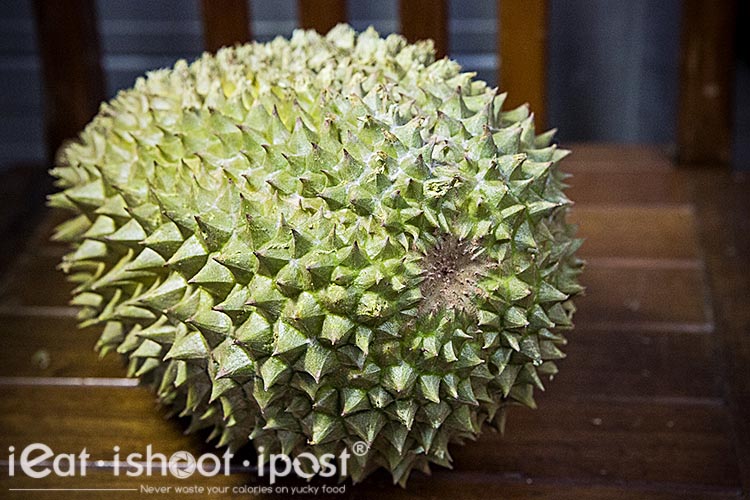
The Tawa is usually a medium sized fruit with large thorns and oblong in shape. The thorns and colour of the fruit look quite similar to the Mao Shan Wang. But it is more slender and there is a characteristic depression at the bottom of the fruit.
The flesh of the Tawa is milky yellow and the texture is light but creamy with little fibre. When it is very ripe, the flesh gets really wet and that is when it gets bitter. The bitterness is not like the XO where you can really get that alcoholic buzz. It is, however, a very good durian if you like bitter durians.
15. D123 Chanee
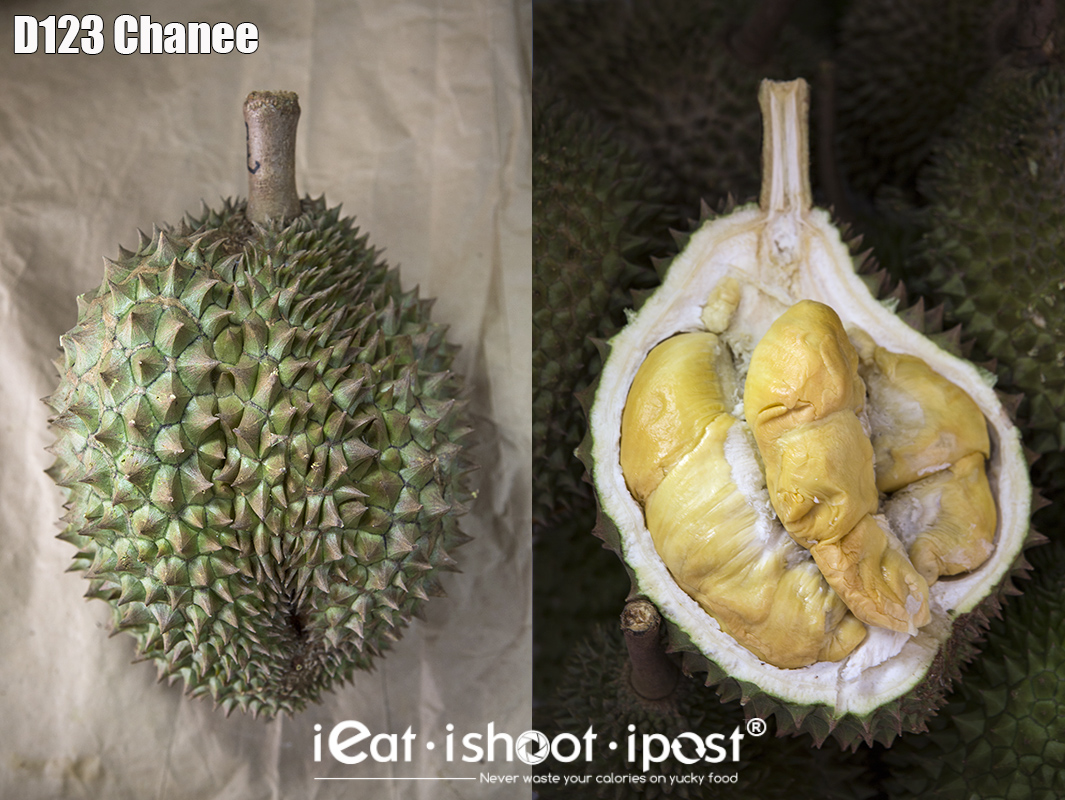
So what do you do if you have a serious durian craving in between seasons? Well, you can still get Thai durians and the one they often import is the D123 Chanee. The fruit is can sometimes be mistaken as a Mao Shan Wang because of its thick yellow flesh. Indeed it is sometimes sold at Mao Shan Wang prices by unscrupulous durian sellers.
The Chanee is usually a large sized fruit with greyish green husk, and thick thorns with brownish tips. The flesh is golden yellow, thick and creamy and it has a strong aroma. However, compared to a Mao Shan Wang, the flavour is much less complex. It doesn’t have that bitterness to balance out the sweetness. It is however still a very good durian to eat, except that you shouldn’t be paying Mao Shan Wang prices for it!
16. D88
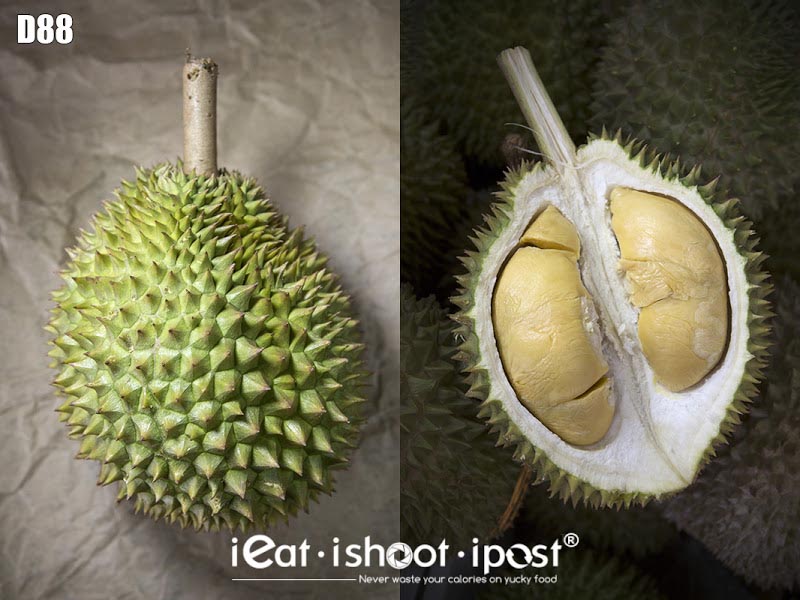
The D88 is a medium sized fruit that is usally pear shaped. I like to think that it looks like a lady in her third trimester of pregnancy! The thorns are thick and is light green at the base, yellowish green in the middle and end with a brownish tip.
The flesh of the D88 is always stunning. It has a very impressive, well endowed pastel chrome yellow flesh. It is not too sweet, dry and pastey and has a very distinct linear bitterness. It just tastes like a straightforward bitterness that runs parallel with the sweetness rather than being mixed in together with it.
17. D100
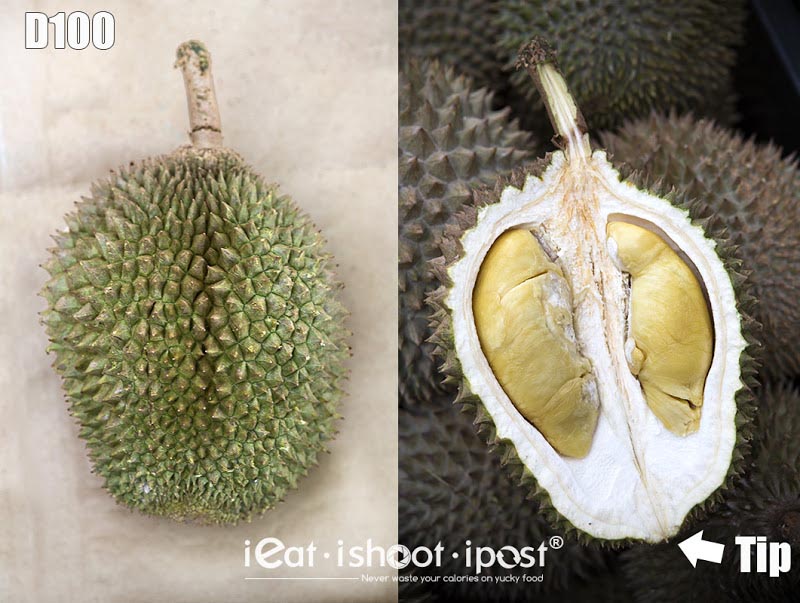
The D100 is very similar to the D24 in terms of the flesh as it is generous, thick and yellow but the flavour is more intense. If you manage to get one like the one shown at the top of this post with dark greyish areas, then you are really in for a treat!
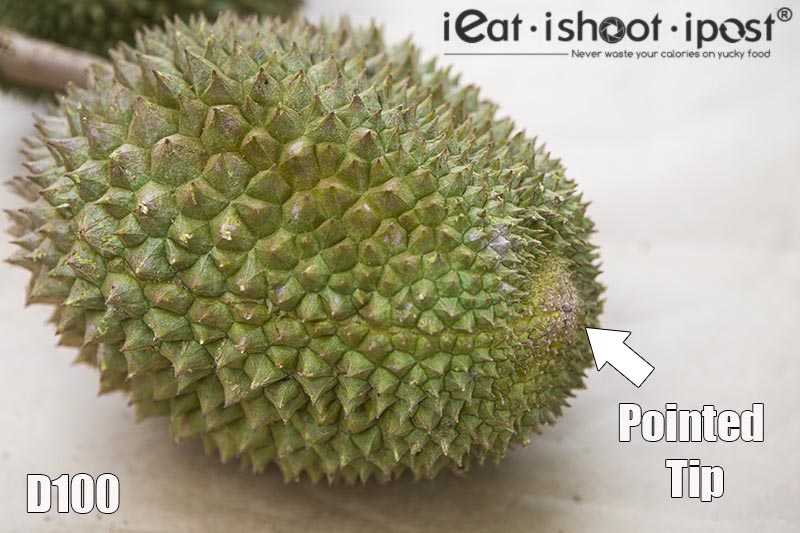
This fruit is also quite small, usually around 1 to 2 kg and the distinctive feature is the pointed tip at the base of the Durian.
D100 is available from 717 Trading.
18. D4
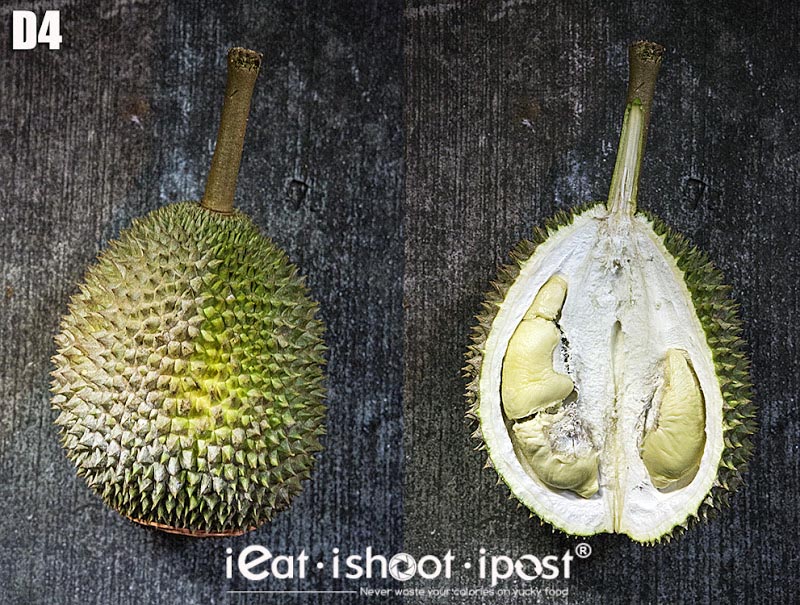
The D4 is not popular with the durian sellers because they ripen quickly after dropping off the trees. So by the time they reach Singapore later in the day, they would invariably start splitting at the seams. Most of these durians will thus have rubber bands at their base to prevent them from splitting further. The other less desirable quality of these durians is their varied shape. The one I featured is round, but the batch of durians came in all shape and sizes. There are also few arils (seeds) per section. They are characterized by smallish thorns.
The flesh of the D4 is milky white in colour and when you are able to get a good one, the flesh has a unique bitterness which connoisseurs look for. It is usually creamy and not fibrous. They usually start appearing in Mar and the season is very short.
19. Ai Ching Guo/爱情果 – The Love Fruit

“Why is this durian called the “Love Fruit?”
Well, it turns out that the fruit was the result of two brothers competing with each other to produce the best Durians. The story goes that their plantations were visited by a young couple who carved out a cupid sign on the trunk of the Durian tree! Apparently both brothers found the sign on their trees and so they called their Durian 爱情果 ie the Love Fruit!
The Durian itself is a medium sized fruit with thick thorns and light green in colour. The flesh is dry, pastey, very smooth and not overly sweet. Not quite pungent enough for me, but maybe it’s one for the young starcrossed lovers!
Ai Ching Guo is available from Kong Lee Hup Kee
20. Pulau Ubin Durians

The fact that there are Pulau Ubin Durians might be of a surprise to you. But for Durian devotees and especially the one’s who have lived through Singapore’s Golden Age of Durians, Pulau Ubin Durians are a time portal to an era where the coming of the Durian season was as eagerly anticipated as the Malaysian Cup Finals.
These are what we call “Kampung” durians and each fruit has it own character and flavour. You can visit Pulau Ubin during the durian season to compete with the other durian harvestors or head down to Wan Li Xiang at Dempsey to look for it!
21. D145 Durian Hijau/Cheh Kak
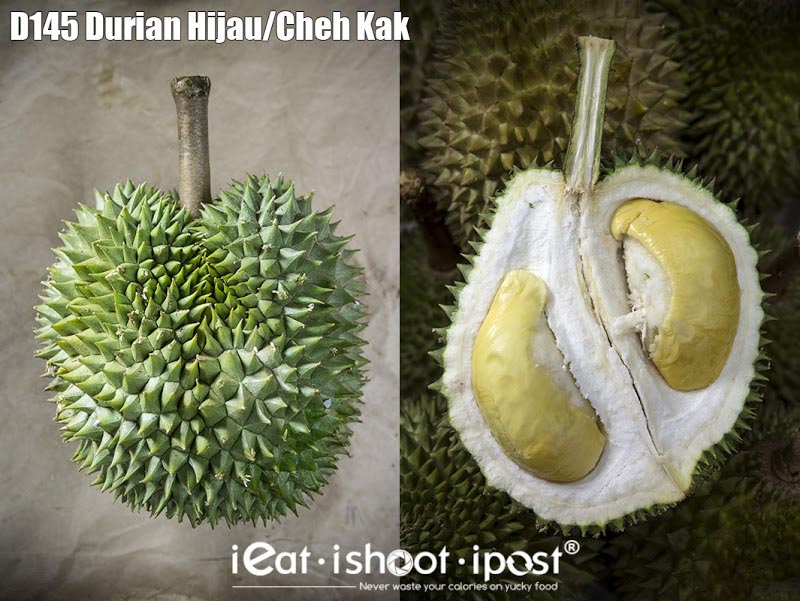
D145 aka Cheh Kak which literally means “Green Husk”. One look at the fruit and you would know why. What I really want to know is why is wasn’t named according to its heart shaped husk which is characteristic of the cultivar?
The flesh is yellow, dry and pastey and predominantly sweet, but not cloying. It leaves your palate with a calm neutral finish which we Teochews like to call “Karm Karm”. Personally, it lacked character, but it should appeal to those who don’t like their durians too pungent.
22. Lao Tai Po

This particular durian is only grown in Yong Peng and the plantations have been around for a long time so the durians all come from very old trees. In the past, the Lao Tai Po wasn’t a popular cultivar among the durian sellers because there there were a lot of unripe fruits falling off the trees, not many durian sellers wanted to carry them. However, the quality has improved markedly over the years and the prices have been steadily going up!
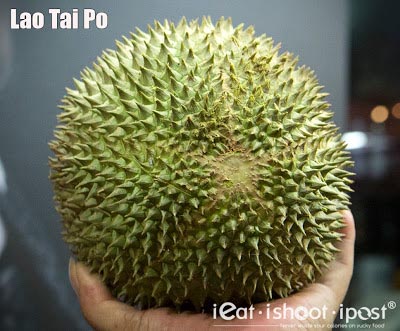
The fruit is mid to large size, elongated with dark green husk and small spines. It has a star shaped pattern at the base like the Mao Shan Wang but it looks a little different as the centre of the star is empty (See photo).
If you like Mao Shan Wang, then you will probably like the Lao Tai Po. That’s because the thick, yellow, smooth and creamy flesh with small vestigial seeds is very similar to the Mao Shan Wang. However, the flavour is a little different. But just like Mao Shan Wang, you can get a range of bitterness depending on the fruit. Overall, it is one of those Durians that most people will like. The thin husk and small vestigial seeds also mean that you get quite a bit of satisfaction from each fruit.
23. D2 Dato Nina

The D2, known as Dato Nina is one of the earliest durians to be registered (1934) It used to be quite popular in the eighties, but nowadays it has fallen out of favour because it is not a fleshy durian and it is a quite difficult fruit to open despite its thin husk.
The fruit is characteristically described as kidney shaped and lopsided with a brownish husk, small thorns and weighs between 1.5 – 1.8kg. ItThe core of the durian is distinctively wide, the husk thin and the flesh is dry and bronze yellow in colour. It resembles the Ang Hei in many ways. Despite it not being fleshy, this durian is really worth a try as it has a distinct flavour like that of a mellow botrytis semillon or for those non-wine drinkers, raisins soaked in cognac.
24. Ten Ten
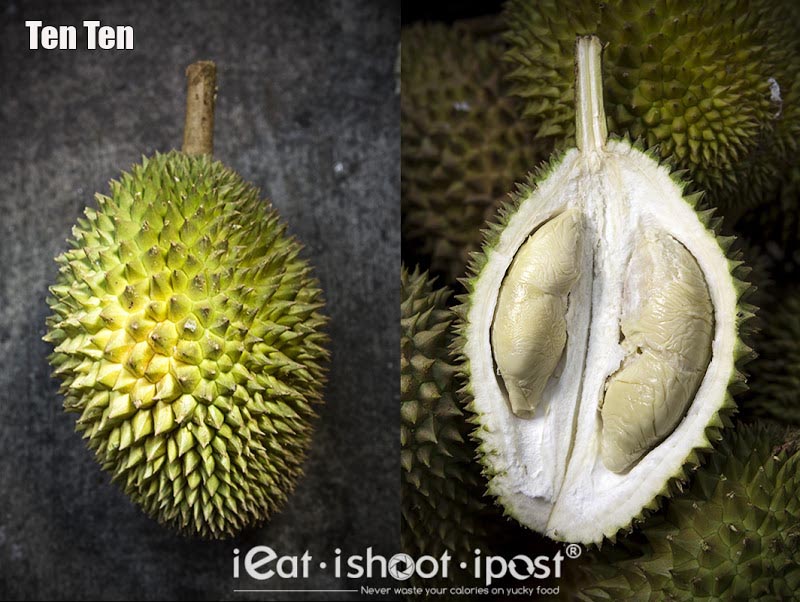
If you enjoy XO Durians then you will like the Ten Ten. This smallish durian (around 1kg) is easy to identify because its light green husk is usually spotlighted with an area of light yellow. Like the XO, the flesh is light greyish yellow in colour and runny just underneath the tight membrane. Just like the XO, the bitterness of the flesh is very distinct and lingers on the back of the palate.
25. D78
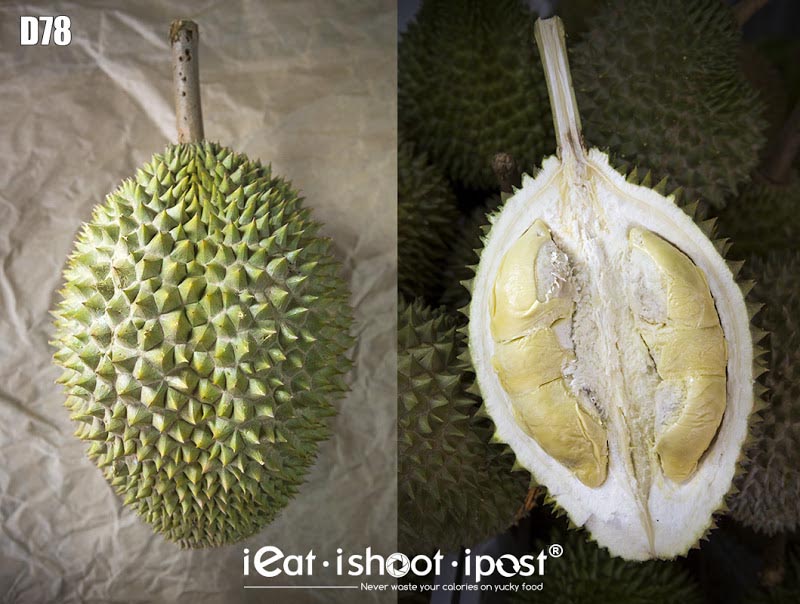
The D78 is a medium to large sized fruit is typically shaped like a rugby ball and it has thick thorns. The flesh is a pale yellow colour, not too sweet, dry and creamy with just a touch of bitterness. The flesh is usually quite mild and a good durian to start with before moving to the more pungent ones.
d the husk is thin and brownish green in colour.
26. Ice Cream Durian
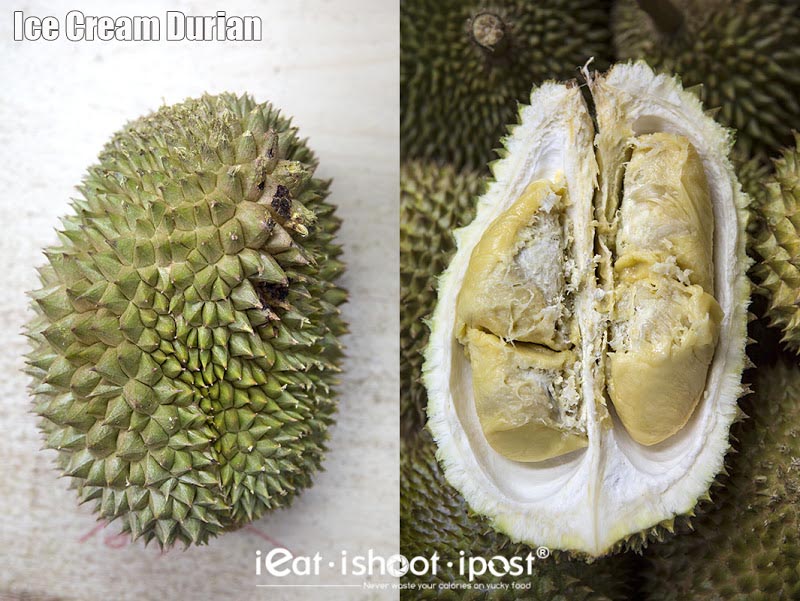
Kasap or Ice Cream durian is a less known breed. The fruit ripens quickly so by the time it gets to Singapore it is usually very soft and watery. So soft and watery that some people say that it can only be eaten with a spoon. That may be one of the reasons it is called Ice Cream Durian. Another explanation is that the soft yellow flesh has a strong vanilla aftertaste, much like vanilla ice cream. Yet another durian uncle told me that it was because there used to be an Ice cream man who used to always buy these durians to make durian Ice Cream! Which is the right theory? Its up to you to decide.
The fruit is not particularly attractive and is often twisted, but I wouldn’t pass the opportunity to give it a try if you like your Durian sweet and watery.
27. Kasap Merah

The Kasap Merah is more of a boutique Durian that does not have the mass appeal of a Mao Shan Wang. But it does have its own fans who specially seek them out for their dry, pastey and sticky flesh and it is distinctly less sweet than most of the other more popular cultivars.
28. D13.5
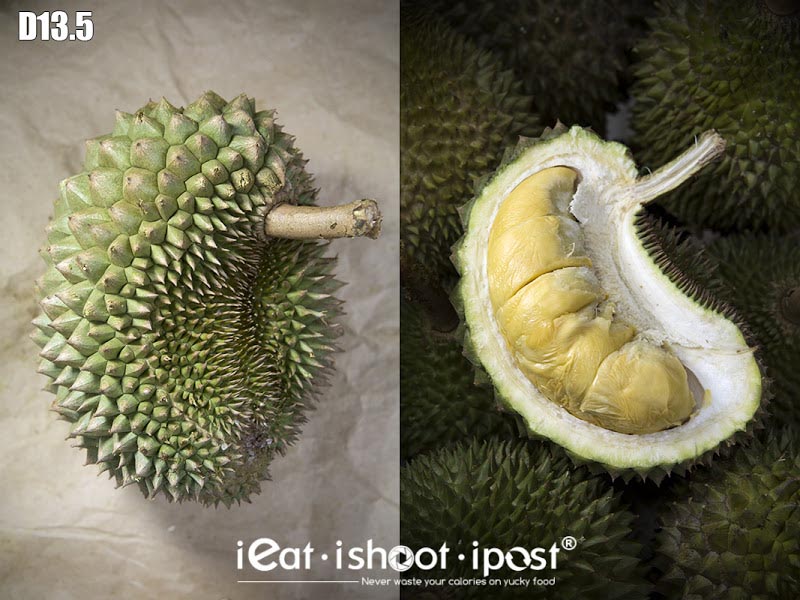
It’s called “13 and a half” because the plantation owner found this particular cultivar growing within a D13 plantation and didn’t have a name for it.
The husk itself is very distinctive. Its extra broad green thorns end with a brownish tip which make it look very much like a tortoise shell. The flesh is thick, deep yellow, sweet and creamy and not pastey so it is quite light on the palate. If you come across a D13.5, go for it.
29. Durian Dalit
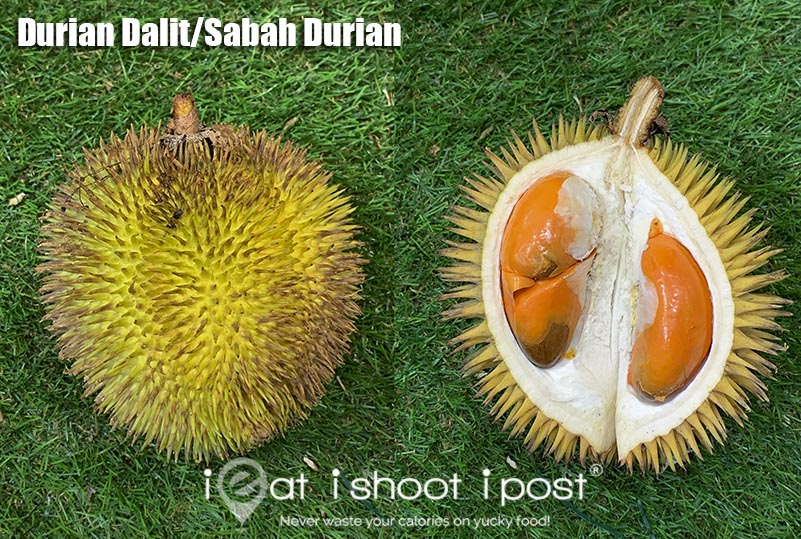
This is a wild durian that is usually found in Sabah. The season is from October to December. It is a different species of durian altogether – durio oxleyanus instead of durio zibethinus.
The fruit is usually small, the size of a sepak takraw ball, with long, spindly and soft spines. The flesh is deep orange colour with a dry pastey texture akin to dry orh nee (mashed taro). The fruit isn’t particularly pungent and tastes like a cross between watermelon, cempadak and bubble gum. If you have grown up with durio zibethinus, it will take a while to get accustomed to the flavour. Most Singaporeans who have tasted it once didn’t want to try it again.
I found it at 99 Old Trees, but it is not for sale, they just had a batch for sampling.
Places to buy durians
Here is a short list of durian stalls which I have visited over the years which are quite reliable. You can click on the name of the stall to read their story!
Central
Combat Durians
One of the durian pioneers with access to old trees and a wide range of quality fruits. Coined the names “Sultan” and “King of Kings”.
249 Balestier Rd, Singapore 329714
Map and Details
99 Old Trees
Durians direct from Fook Gor Farm in Raub – good for Mao Shan Wang. Nice air con environment with bar counter for durian omakase! Next gen durian seller
Blk 46 Owen Road #01-277
MAP and Details
Bao Jiak
Young entrepreneurs serving the popular cultivars.
202 Ang Mo Kio Ave 3, #01-1682
MAP and details
Ah Di/Wan Li Xiang
Old durian seller with access to Pulau Ubin durians!
7 Dempsey Road
Map and details
East
227 Katong Durian
Established durian seller with wide range of durians and access to old trees. Air con environment
227 E Coast Rd
Map and Details
Leong Tee Fruit Trading
Reliable durian seller specializing in Mao Shan Wang from old trees.
264 Tanjong Katong Rd
Map and Details
818 Trading
New generation durian seller with own farm and very high quality Mao Shan Wang. The owner was the one who coined the name “Black Gold”.
201 Telok Kurau Rd, #01-02
Map and Details
Kong Lee Hup Kee
Pioneer durian seller with a wide range of difficult to find durians and access to old trees.
440 Pasir Ris Drive 4, #01-03
Map and Details
Ah Kok Durians
Well known for his Gang Hai and other cultivars
Blk 441A, Pasir Ris Drive 6 #01-74
Map
North East
717 Trading
Pioneer durian seller with wide range of durians, access to old trees and unusual cultivars like D100.
Highland Centre, #01- 01, 22 Yio Chu Kang Rd
Map and Details
Spike Empire
Own farm in Tangkak – good for a wide range of Johor durians. D24 and MSW durian paste available. Next gen durian seller.
Blk 7 Hougang Ave 3, #01-56
9398 4090
MAP and Details
Durian Story
Good range of durians, nice air con environment. Next gen durian seller.
151 Serangoon North Ave 2, #01-11
Map and Details
North
Durian Seng
Quirky durian seller who gives away free durians during his birthday! Difficult to find cultivars like Lao Tai Po, Ten Ten can be found here as well as a wide range of other cultivars. Still selling from a make shift stall outside a beauty spa.
18 Jln Tampang, Sembawang
Map and Details
West
Ah Seng Durian
Very popular durian seller with wide range of durians and hard to find cultivars like kasap merah and ice cream durians.
Ghim Moh Market
Map and Details
Durian Tree
Reliable seller, wide range of durians including S17.
277 Bukit Batok East Ave 3, #01-371
Map and Details
Hope you enjoyed reading my ultimate durian guide.



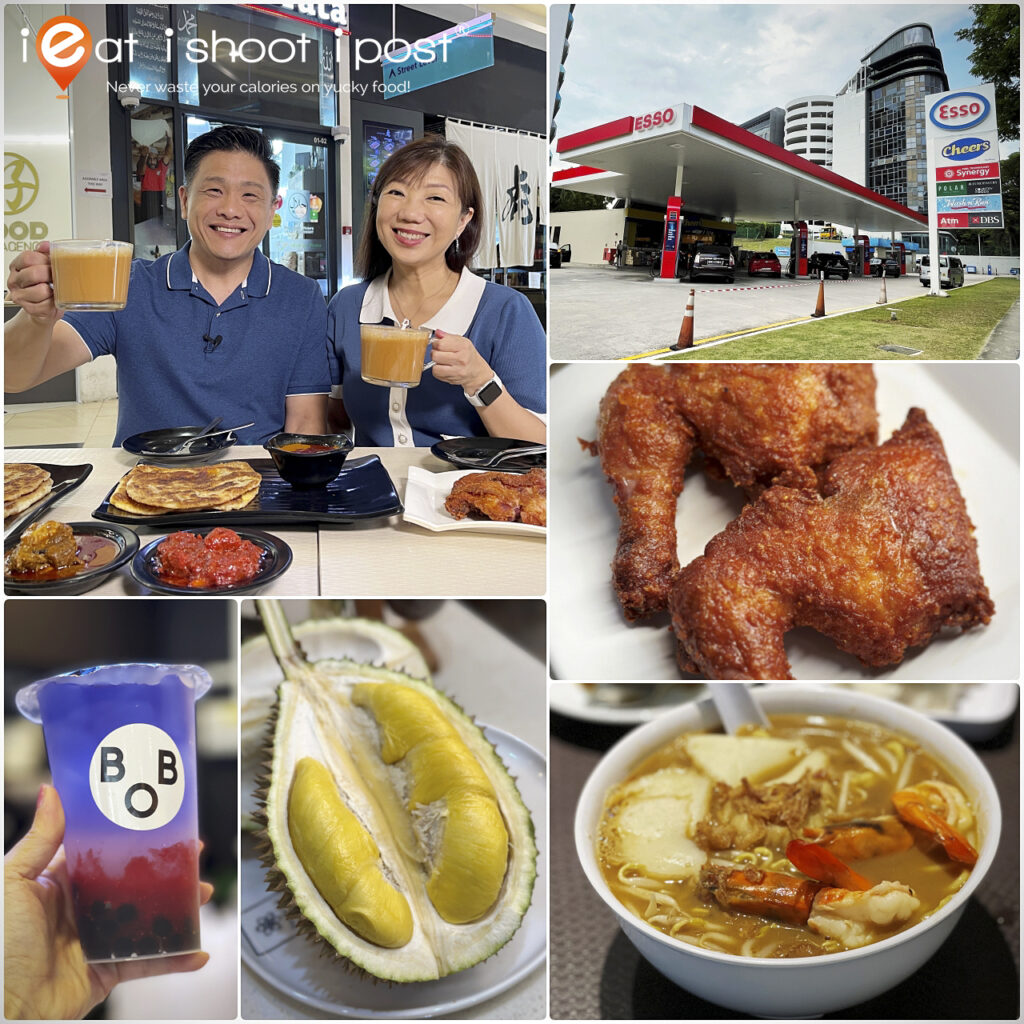

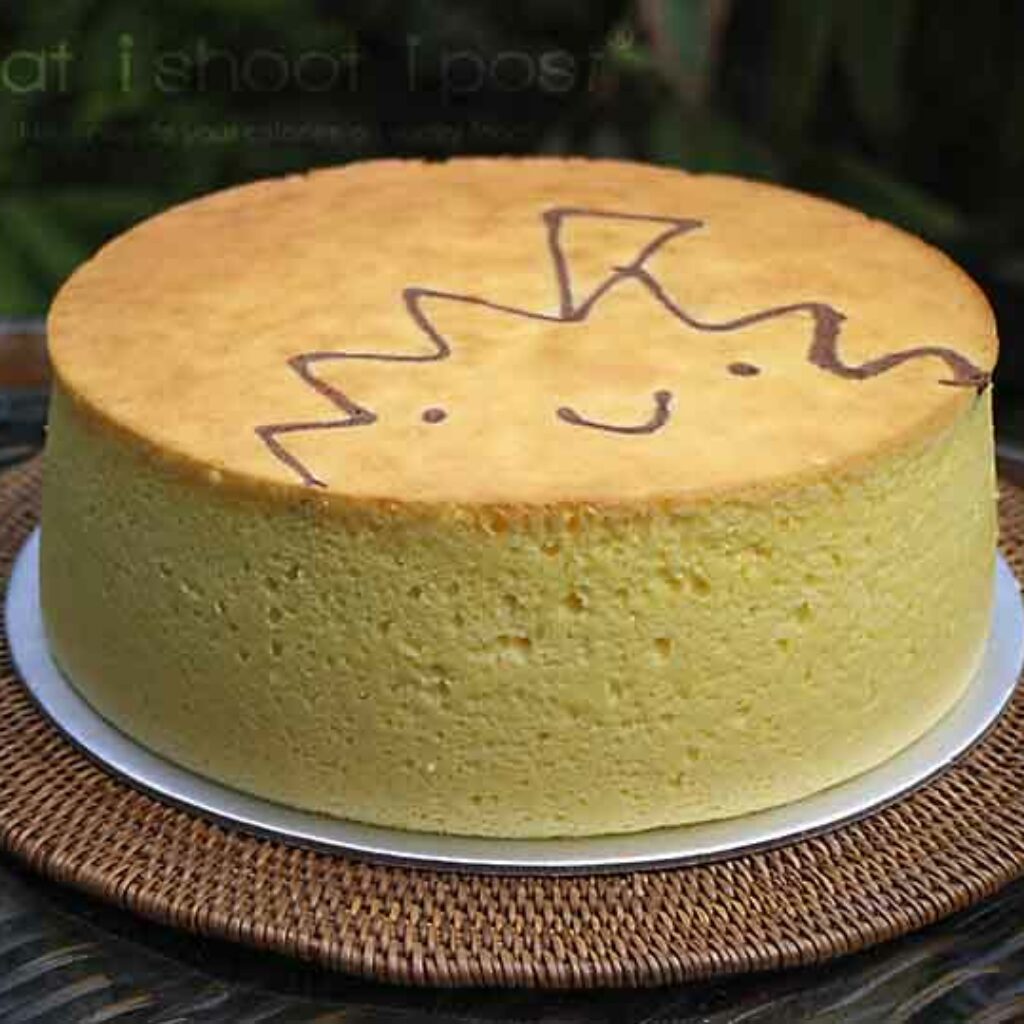
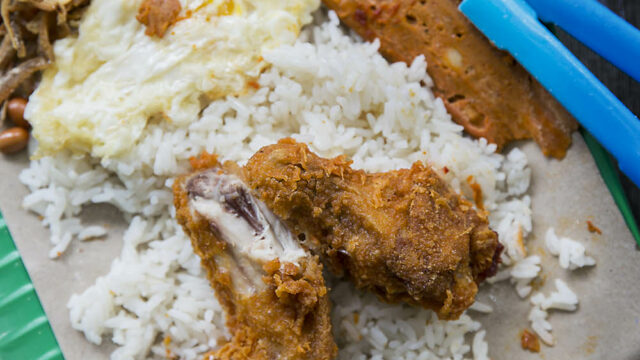
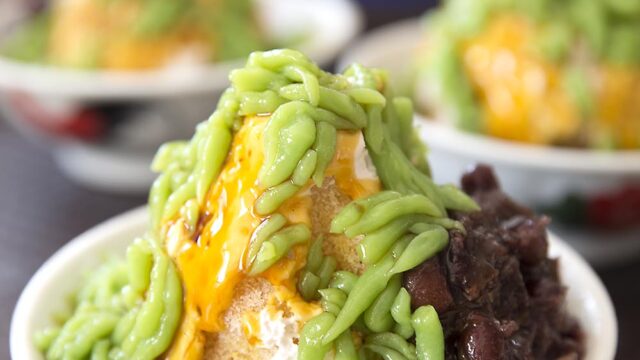



Sheng Siong sells two types of Balck Gold at $22 and $18 per kg respectively from Pahang and Johore Muar. I am told price gap is due to age of durian plantation. Is this valid in your opinion? Can you actually classified a durian as black gold if the pedigree differs?
I haven’t actually seen the durians at Sheng Shiong, so its difficult to comment.
There is a durian name called Mei Qiu D828 very nice taste if you like bitter taste you will love it, recently got it from Durian Empire @ Punggol Plaza.